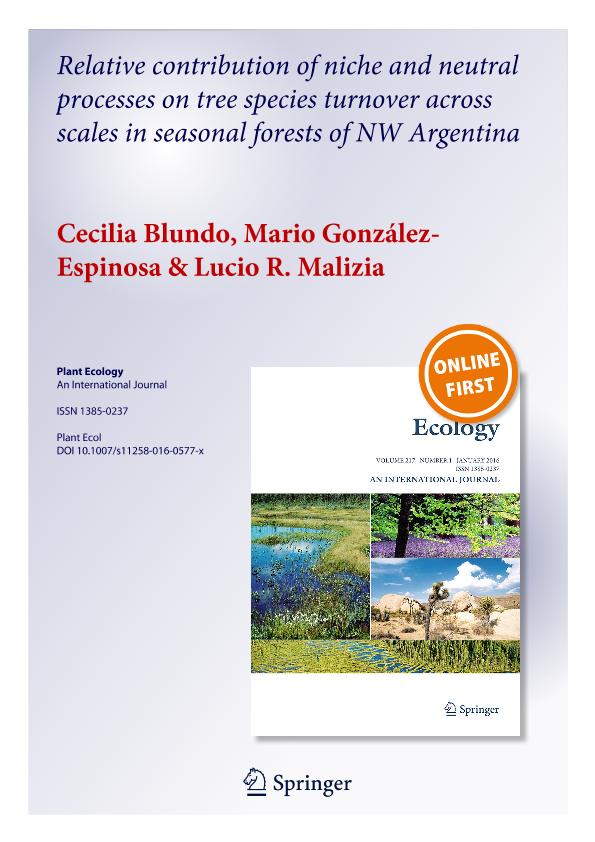Mostrar el registro sencillo del ítem
dc.contributor.author
Blundo, Cecilia Mabel

dc.contributor.author
González Espinosa, Mario
dc.contributor.author
Malizia, Lucio Ricardo

dc.date.available
2018-10-11T19:11:08Z
dc.date.issued
2016-04
dc.identifier.citation
Blundo, Cecilia Mabel; González Espinosa, Mario; Malizia, Lucio Ricardo; Relative contribution of niche and neutral processes on tree species turnover across scales in seasonal forests of NW Argentina; Springer; Plant Ecology; 217; 4; 4-2016; 359-368
dc.identifier.issn
1385-0237
dc.identifier.uri
http://hdl.handle.net/11336/62237
dc.description.abstract
Environmental heterogeneity and dispersal limitation influence tree species distribution, but their relative contributions change with the spatial scale of analysis. We analyzed tree species turnover using twenty 1-ha permanent plots to quantify variation in floristic similarity explained by environmental factors and geographical distance at regional (among plots) and local (within plots) scales in seasonal premontane forests of northwestern Argentina. We related floristic similarity (Bray–Curtis) with environmental variation and geographical distance using specific regression models (regression of distance matrix and mixed-effects models at regional and local scales, respectively). Floristic similarity decreased with distance at both spatial scales but its relative contribution was significant only at the regional scale (18 and <1 % at regional and local scale, respectively). Dispersal limitation may be a relevant process at biogeographical scale where dispersion at large distances become infrequent for some species. In addition, we identified that regional climatic and topographic gradients and local edaphic variation contribute to explain floristic similarity across scales in seasonal premontane forests. Environmental heterogeneity explained about the same variance in floristic similarity at regional and local scales (7 and 8 %, respectively). We conclude that quantitative aspects of floristic patterns, such as the relative contribution of niche and neutral processes to explain species distribution, can strengthen conservation strategies at different spatial scales, and therefore could be a useful tool in conservation planning.
dc.format
application/pdf
dc.language.iso
eng
dc.publisher
Springer

dc.rights
info:eu-repo/semantics/openAccess
dc.rights.uri
https://creativecommons.org/licenses/by-nc-sa/2.5/ar/
dc.subject
Climate
dc.subject
Dispersal Limitation
dc.subject
Environmental Heterogeneity
dc.subject
Soil Texture
dc.subject
Topography
dc.subject.classification
Otras Ciencias Biológicas

dc.subject.classification
Ciencias Biológicas

dc.subject.classification
CIENCIAS NATURALES Y EXACTAS

dc.title
Relative contribution of niche and neutral processes on tree species turnover across scales in seasonal forests of NW Argentina
dc.type
info:eu-repo/semantics/article
dc.type
info:ar-repo/semantics/artículo
dc.type
info:eu-repo/semantics/publishedVersion
dc.date.updated
2018-10-09T20:34:41Z
dc.journal.volume
217
dc.journal.number
4
dc.journal.pagination
359-368
dc.journal.pais
Alemania

dc.journal.ciudad
Berlin
dc.description.fil
Fil: Blundo, Cecilia Mabel. Universidad Nacional de Tucumán. Instituto de Ecología Regional. Consejo Nacional de Investigaciones Científicas y Técnicas. Centro Científico Tecnológico Conicet - Tucumán. Instituto de Ecología Regional; Argentina
dc.description.fil
Fil: González Espinosa, Mario. El Colegio de la Frontera Sur; México
dc.description.fil
Fil: Malizia, Lucio Ricardo. Consejo Nacional de Investigaciones Científicas y Técnicas; Argentina. Universidad Nacional de Jujuy. Facultad de Ciencias Agrarias; Argentina
dc.journal.title
Plant Ecology

dc.relation.alternativeid
info:eu-repo/semantics/altIdentifier/url/https://link.springer.com/article/10.1007/s11258-016-0577-x
dc.relation.alternativeid
info:eu-repo/semantics/altIdentifier/doi/https://dx.doi.org/10.1007/s11258-016-0577-x
Archivos asociados
